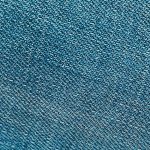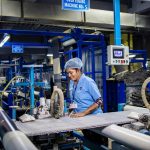You can source wholesale denim fabric directly from Chinese mills by identifying reputable manufacturers with strong certifications and production capacity. Focus on fabric specifications like weight, fiber content, and dye quality to guarantee you get the right product. Negotiate pricing based on order size and build good supplier relationships for better terms. Also, consider shipping, import regulations, and compliance documentation. Keep exploring to uncover customization options and emerging industry trends that can enhance your sourcing strategy.
Table of Contents
Key Takeaways
- Identify reputable Chinese denim mills by verifying certifications, production capacity, and requesting fabric samples for quality assessment.
- Focus on fabric types like rigid, stretch, selvedge, colored, and eco-friendly denim based on your target market needs.
- Negotiate pricing by understanding market trends, leveraging order volume, and requesting detailed cost breakdowns.
- Account for lead times affected by production capacity, minimum order quantities, and seasonal fluctuations.
- Choose appropriate shipping methods, prepare all compliance documents, and maintain clear communication with suppliers for smooth import and delivery.
Understanding the Denim Fabric Market in China
Although the denim fabric market in China is vast and complex, understanding its key players and trends can help you make informed sourcing decisions.
You’ll find that China hosts numerous mills, ranging from small family-owned businesses to large-scale manufacturers, each offering different quality levels and production capacities.
The industry focuses heavily on innovation, with many mills investing in sustainable practices and advanced dyeing techniques.
You should pay attention to regional hubs like Zhejiang and Jiangsu provinces, where denim production is concentrated due to access to raw materials and skilled labor.
Staying updated on pricing trends and export policies will also give you an edge.
Key Types of Denim Fabric Offered by Chinese Mills
When sourcing denim fabric from Chinese mills, you’ll find a diverse range of options tailored to different needs and styles.
These mills produce various denim types, ensuring you get exactly what your brand or project requires. Here are the key types you’ll encounter:
- Rigid Denim: Classic, unwashed fabric that softens with wear.
- Stretch Denim: Blended with elastane for flexibility and comfort.
- Selvedge Denim: Known for its finished edges, prized for durability and style.
- Colored Denim: Dyed in hues beyond traditional indigo for unique designs.
- Eco-Friendly Denim: Made using sustainable processes and organic cotton.
How to Identify Reputable Denim Manufacturers
You’ll want to start by checking a manufacturer’s certifications and compliance with industry standards to guarantee quality and ethical practices.
Next, verify their production capabilities to confirm they can meet your volume and timeline needs.
Doing these checks helps you partner with a reliable denim supplier.
Certifications and Compliance
To guarantee you’re working with reputable denim manufacturers, start by checking their certifications and compliance with industry standards.
These credentials prove they meet quality, environmental, and ethical benchmarks, confirming your fabric source is trustworthy and responsible.
Here are key certifications to look for:
- OEKO-TEX Standard 100: Confirms textiles are free from harmful substances.
- ISO 9001: Indicates a robust quality management system.
- SA8000: Guarantees fair labor practices and safe working conditions.
- GOTS (Global Organic Textile Standard): Certifies organic fiber content and eco-friendly processing.
- Bluesign: Highlights sustainable and safe textile manufacturing.
Production Capabilities Verification
Although certifications provide a solid foundation, verifying a manufacturer’s production capabilities guarantees they can consistently meet your denim fabric demands. You should assess their machinery, workforce skills, and output volume. Request samples and production timelines to confirm quality and reliability. Visiting the mill or arranging virtual tours helps you inspect operations firsthand.
| Aspect | What to Check | Why It Matters |
|---|---|---|
| Machinery | Modern looms, maintenance | Guarantees fabric quality |
| Workforce Skills | Trained technicians | Maintains consistent output |
| Production Volume | Capacity vs. your demand | Avoids delays or shortages |
Evaluating Denim Quality and Fabric Specifications
When evaluating denim quality and fabric specifications, you need to focus on key factors like weight, weave, and fiber content. These elements directly impact durability, comfort, and appearance.
Start by checking the fabric weight, usually measured in ounces per square yard, to match your product needs. Consider the weave type—twill is common for its diagonal pattern and strength. Fiber content matters too; cotton offers breathability, while blends can add stretch or resilience.
Don’t forget to inspect the dye quality and finish, as these influence colorfastness and feel. Here’s what to look for:
- Fabric weight (e.g., 10 oz, 14 oz)
- Weave style (right-hand or left-hand twill)
- Fiber composition (100% cotton or blends)
- Indigo dye quality and consistency
- Surface finish and texture uniformity
These checks help guarantee you pick the best denim for your line.
Customization Options Available at Chinese Denim Mills
Since customization plays an essential role in setting your denim apart, Chinese denim mills offer a wide range of options to tailor fabrics to your exact needs.
You can choose from various weights, blends, and finishes to match your design vision and target market. Whether you want raw, selvedge, or pre-washed denim, mills can accommodate your preferences.
You can also specify details like yarn count, dyeing techniques, and stretch levels to guarantee comfort and durability. Additionally, mills provide custom weaving patterns and unique treatments such as enzyme washes or laser effects.
Pricing Structures and Negotiation Tips
Understanding pricing structures is essential if you want to get the best value from Chinese denim mills. Prices usually depend on fabric quality, order size, and current market trends.
To negotiate effectively, keep these tips in mind:
- Research standard market prices to avoid overpaying.
- Ask for a detailed cost breakdown to understand pricing components.
- Leverage your order size to negotiate discounts or better payment terms.
- Be clear about your budget but remain flexible on customization to save costs.
- Build a rapport with the supplier; trust often leads to better deals.
Minimum Order Quantities and Production Capacity
When sourcing wholesale denim fabric, you’ll need to understand typical minimum order quantities (MOQs) that suppliers require.
It’s important to contemplate how production capacity can scale with your demand and how lead times might impact your schedule.
Knowing these factors will help you plan your orders efficiently and avoid delays.
Typical MOQ Requirements
Although sourcing wholesale denim fabric offers many advantages, you’ll need to meet certain minimum order quantities (MOQs) that suppliers require to start production.
These MOQs guarantee mills operate efficiently and cover setup costs. Typically, MOQs vary based on fabric type, quality, and mill capacity.
Here’s what you can generally expect:
- MOQs range from 500 to 2,000 meters per order
- Specialty denim or custom dyeing often demands higher MOQs
- Basic denim fabrics usually have lower minimums
- Some mills allow sample runs with considerably smaller quantities
- Lead times can depend on order size and current production schedule
Understanding these requirements helps you plan your purchase effectively and avoid surprises during sourcing.
Scaling Production Volume
Meeting minimum order quantities is just one part of scaling your production volume effectively. You also need to understand the mill’s production capacity to avoid delays or overcommitment. As your orders grow, verify the supplier can handle larger volumes without compromising quality. Communicate your volume projections clearly to negotiate better terms.
| Production Volume (meters) | Typical MOQ (meters) |
|---|---|
| Small | 500 – 1,000 |
| Medium | 1,000 – 5,000 |
| Large | 5,000 – 20,000 |
| Extra Large | 20,000 – 50,000 |
| Bulk | 50,000+ |
Matching your demand with these scales helps you optimize costs and maintain steady supply.
Lead Time Considerations
Because minimum order quantities and production capacity directly impact lead times, you need to factor them into your scheduling early. If you don’t, you risk delays that could derail your entire production timeline.
Chinese mills often require minimum orders that might exceed your immediate needs, so plan accordingly. Also, keep in mind their current production load—high demand can extend your wait time.
Consider these lead time factors:
- Minimum order quantities set baseline production size.
- Larger orders might reduce per-unit lead time.
- Production capacity fluctuates seasonally.
- Communication delays can slow order confirmation.
- Shipping and customs add unpredictable time.
Shipping and Logistics Considerations
When sourcing wholesale denim fabric, you’ll want to carefully plan your shipping and logistics to avoid delays and extra costs. Choosing the right shipping method—air, sea, or land—depends on your budget and urgency. Coordinating with reliable freight forwarders can streamline customs clearance and guarantee timely delivery. Packaging should protect the denim from moisture and damage during transit. Tracking shipments and having contingency plans for delays helps you stay on schedule.
| Shipping Method | Typical Transit Time | Cost Consideration |
|---|---|---|
| Sea Freight | 20-40 days | Most economical |
| Air Freight | 3-7 days | Most expensive |
| Rail Freight | 15-25 days | Moderate cost |
| Courier (e.g., DHL) | 2-5 days | Expensive, for samples |
| Trucking | Varies (land routes) | Depends on distance |
Navigating Import Regulations and Duties
When importing denim fabric from China, you need to understand the specific import rules to avoid delays.
Calculating import duties accurately helps you budget effectively and prevent unexpected costs.
Make sure you have all the necessary compliance documents ready to clear customs smoothly.
Understanding Chinese Import Rules
Although importing denim fabric from China can offer cost advantages, you need to navigate a complex web of regulations and duties to secure smooth customs clearance.
Understanding the Chinese import rules helps you avoid delays and unexpected fees. Here’s what you should focus on:
- Make sure your supplier provides accurate product descriptions and relevant certifications
- Verify compliance with China’s textile import standards and safety regulations
- Prepare all necessary documents like commercial invoices, packing lists, and bills of lading
- Register with Chinese customs if required for your business type
- Stay updated on any changes to import policies or trade agreements affecting textiles
Calculating Import Duties
Since import duties can greatly impact your overall costs, you’ll want to accurately calculate them before sourcing wholesale denim fabric. Duties depend on the fabric’s classification, value, and country of origin. Check the Harmonized Tariff Schedule (HTS) codes to find the exact rate. Remember, even small miscalculations can eat into your profit margins.
Here’s a quick example to help visualize:
| Fabric Type | HTS Code | Duty Rate (%) |
|---|---|---|
| Cotton Denim | 5209.42 | 12.5 |
| Stretch Denim | 5211.49 | 10.0 |
| Blended Denim | 5212.93 | 15.0 |
Use this info to estimate your costs accurately and avoid surprises at customs.
Compliance Documentation Essentials
Understanding and organizing the necessary compliance documents guarantees smooth customs clearance and avoids costly delays when importing wholesale denim fabric.
You need to be proactive in gathering and verifying these documents to meet import regulations and duty requirements effectively.
Key documents you should prepare include:
- Commercial Invoice detailing the transaction and pricing
- Bill of Lading or Airway Bill for shipment tracking
- Packing List specifying quantities and descriptions
- Certificate of Origin proving fabric origin for duty classification
- Import License or permits if required by your country
Building Long-Term Relationships With Chinese Suppliers
When you commit to building long-term relationships with Chinese suppliers, you create a foundation of trust and reliability that benefits both parties. Consistent communication, timely payments, and mutual respect strengthen these partnerships. Over time, suppliers may offer better prices, priority production, and improved quality as a result of your loyalty.
| Strategy | Benefit |
|---|---|
| Regular Communication | Avoid misunderstandings |
| On-time Payments | Builds financial trust |
| Visit Factories | Deepens personal connection |
| Share Feedback | Enhances product quality |
Emerging Trends in Chinese Denim Fabric Production
As you explore sourcing denim fabric from China, you’ll notice manufacturers are adopting innovative techniques to meet global demand.
Chinese mills are embracing sustainability, advanced dyeing technology, and customization to stay competitive. You’ll find these emerging trends particularly impactful:
- Use of eco-friendly fibers and water-saving production methods
- Integration of digital printing for unique denim patterns
- Development of stretch denim with improved comfort and durability
- Adoption of automated looms for higher precision and efficiency
- Collaboration with international designers to align with fashion trends
Frequently Asked Questions
What Environmental Certifications Do Chinese Denim Mills Typically Have?
Imagine walking through a clean, green factory; you’ll often find Chinese denim mills holding certifications like OEKO-TEX, GOTS, and bluesign®. These prove they care about reducing pollution and ensuring safe, eco-friendly fabric production.
How Do Chinese Mills Handle Fabric Defects and Returns?
When you spot fabric defects, mills usually inspect thoroughly and offer replacements or repairs. They often have clear return policies and work closely with you to resolve issues quickly, ensuring quality and minimizing disruptions.
Are There Specific Payment Methods Preferred by Chinese Denim Suppliers?
You’ll find Chinese denim suppliers often prefer payment methods like T/T (Telegraphic Transfer), L/C (Letter of Credit), or sometimes PayPal for smaller orders. It’s best to clarify terms upfront to guarantee smooth transactions and trust.
What Lead Times Can Buyers Expect During Chinese New Year?
You can expect lead times to extend by 2 to 4 weeks during Chinese New Year, as factories close for holidays. It’s smart to plan orders early to avoid delays and keep your production on track.
Can Mills Provide Fabric Samples Before Placing Bulk Orders?
Wondering if you can see the fabric before committing? Absolutely, mills often provide samples so you can inspect quality firsthand. Just remember, some might charge a small fee or require a minimum order first.
- What Is the Difference Between Cotton and Percale? A Common Question Answered - July 14, 2025
- Are Cotton Percale Sheets Good? An In-Depth Look at Quality - July 14, 2025
- The Difference Between Cotton and Percale Sheets Explained - July 14, 2025







